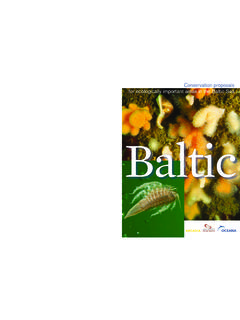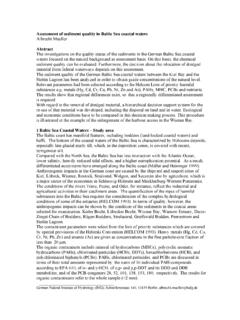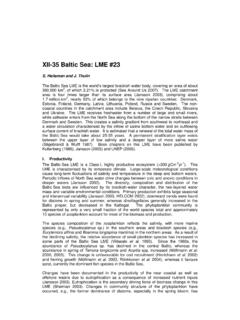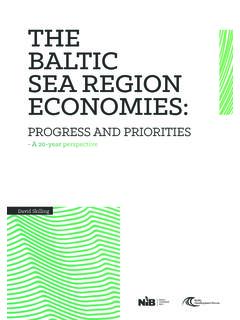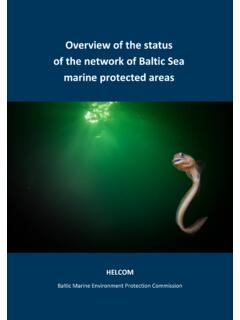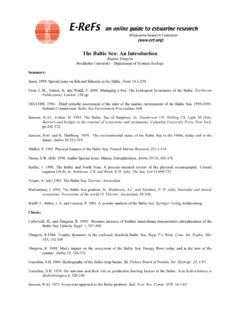Transcription of Baltic Sea Icebreaking Report 2016-2017
1 1 Baltic Icebreaking MANAGEMENT Baltic Sea Icebreaking Report 2016-2017 2 Table of contents 1. Introduction .. 3 2. Overview of the Icebreaking season ( 2016-2017 ) and its effect on the maritime transport system in the Baltic Sea region .. 4 3. Accidents and incidents in sea ice .. 10 4. Winter Navigation Research .. 10 5. Costs of Icebreaking services in the Baltic Sea .. 10 Finland .. 10 Sweden .. 10 Russia .. 11 Estonia .. 11 Latvia, Lithuania, Poland and Germany .. 11 Denmark .. 12 Norway .. 12 6. Winter navigation in the different parts of the Baltic Sea .. 12 Bay of Bothnia .. 12 Sea of Bothnia and the Quark .. Virhe. Kirjanmerkki ei ole m ritetty. Gulf of Finland .. 12 Central Baltic .
2 13 Southern Baltic .. 13 Danish waters, Swedish West coast, Germany and Norwegian waters .. 14 7. Description of organizations and icebreakers engaged during the season 2016-2017 .. 15 Finland .. 15 Sweden .. 16 Russia .. 17 Estonia .. 18 Latvia .. 18 Lithuania .. 18 Poland .. 18 Denmark .. 19 Norway .. 19 8. Progress Report of BIM ( Baltic Sea Icebreaking Management) .. 20 3 1. Introduction Baltic Icebreaking Management, BIM is an organization with members from all Baltic Sea states. BIM is a development of the annual meeting between Baltic Sea States Icebreaking authorities which have assembled since 1982. The member countries of BIM are Denmark, Estonia, Finland, Germany, Latvia, Lithuania, Norway, Poland, Russia and Sweden.
3 After the difficult winter navigation season of 2002/2003 a project was started up within the framework of HELCOM, aiming at improving the safety of winter navigation in the Baltic Sea. The HELCOM recommendation 25/7 on the safety of Winter Navigation in the Baltic Sea Area was adopted in March 2004. Within the EU concept Motorways of the Sea, which is one priority project in the trans-European network, the Baltic Sea countries established a working group with the aim of creating more efficient winter navigation by cooperation between the Baltic Sea countries. The Icebreaking authorities around the Baltic Sea decided at Helsinki meeting 2004 that this work shall continue within the framework of BIM, where also non EU-member states are taking part.
4 BIM should function all year round and its strategy should be to develop safe, reliable and efficient winter navigation between the Baltic Sea countries. The overall objective of BIM is to assure a well-functioning maritime transport system in the Baltic Sea all year round by enhancing the strategic and operational cooperation between the Baltic Sea countries within the area of assistance to winter navigation. On 10 January 2007, the Joint Baltic web service on winter navigation was launched. On 17 June 2015, a new version of the Joint Baltic web service on winter navigation was launched. On 11 April 2007, the DVD of training in ice navigation for seafarers was launched. On 15 November 2007, HELCOM adopted a new recommendation 28E/11 outlining further measures to improve the safety of navigation in ice conditions in the Baltic Sea; BIM was acting an ice advisor in this recommendation.
5 In 2008 the pamphlet The World Icebreaker, Icebreaking Supply and Research Vessel Fleet was presented and updated in 2011. In April 2009, a computer based training program, based on the DVD, was introduced. After completing the course, the student gets a certificate over earned skills. One important task of BIM is to inform stakeholders in the maritime sector and policy makers about winter navigation and Icebreaking . There is a need for information about winter navigation and Icebreaking that covers the whole Baltic Sea region. Several Baltic Sea countries prepare information about the winter navigation and Icebreaking in their respective national waters. There has been a need to coordinate this country-specific information, improve the information and to distribute it to a wider target group by Joint Annual Baltic Icebreaking Report .
6 This Report gives an overview of the winter navigation season 2016/2017 for the Baltic Sea area. National reports can be found on the site The Report will also describe organizational changes in the Icebreaking authorities or changes in Icebreaking resources and provide a progress Report of the Baltic Sea Icebreaking cooperation and the development of BIM. 4 2. Overview of the Icebreaking season ( 2016-2017 ) and its effect on the maritime transport system in the Baltic Sea region According to the Finnish Ice Service of the Finnish Meteorological Institute the Baltic Sea ice season 2016-2017 was mild. The maximum ice extent, 88 000 km , was reached on 12 February. Figure 1. The maximum ice extent of the ice season 2016-2017 was reached on 12 February 2017.
7 5 The freezing started from inner bays of the Gulf of Bothnia in early November. December was exceptionally warm and at the end of December, the extent of sea ice was only 10 000 km . Icebreaker KONTIO started her assistance work on 10 December. January began cold but cold weather continued less than two weeks. At the end of January ice extent was 44 000 km . Again at the beginning of February the weather was quite cold. The peak of the ice winter was reached on 12 February, when the ice extent was 88 000 km . Figure 2. The development of ice season 2016-2017 compared to seasons 2006-2016. Then the weather turned mild and the winds became stronger. At the end of February the ice extent was 77 000 km . Quickly changing and mild weather continued in March.
8 At the end of March the extent of the ice was only 29 000 km . April was colder than usual and ice melting was slow. At the end of April the extent of ice was 15 000 km . Also May was colder than normal and ice melting was very slow the last icebreaker started her voyage home as late as on 25 May. Ice conditions in the eastern part of the Gulf of Finland in 2016-2017 The ice formation processes in the winter of 2016/2017 were those of a mild winter. Ice formation in the coastal shallow zone of the eastern part of the Gulf of Finland began in the second decade of November. By mid-December, the entire water surface of the seaport Big port of Saint-Petersburg was completely covered with ice, the thickness of which was from 5 to 20 cm.
9 6 By mid-January due to the lowering of air temperature solid ice with thickness up to 15 cm spread from the Cape Shepelevskii to the Western Birch Island and reached Rondo Island. In Vyborg Bay and on the waters of Neva Bay fast ice with thickness from 15 to 40 cm was observed. In February, the area of the ice cover gradually increased. By mid-month the ice edge passed from Toila village (Estonia) in the South, through the Western extremity of Powerful Island and Nerve Island to the village of Hamina (Finland) on the Northern shore of the Gulf of Finland. By the end of February nilas ice had spread to the Meridian of Hogland Island. In March, air temperatures were noted around zero degrees, the wind blew mainly from the West and South-West directions.
10 Under the influence of winds solid ice began to shift to the Northern shore of the Gulf of Finland. Ice formation in the Eastern part of the Gulf had slowed, and since the second half of the month it was to be a gradual destruction and melting of ice. The water area of the port of Ust-Luga was cleared of ice. In April, the ice cover continued to break down. In spite of the fact that air temperatures were below the average, the water area of Neva Bay became completely ice free by 10 April. The Icebreaking period in the seaport of Ust-Luga was completed on 21 April 2017, and on 25 April 2017 the Icebreaking periods in all Russian ports of the Gulf of Finland were completed too. Figure 3. The maximum ice coverage in ice winters 1961-2017.
